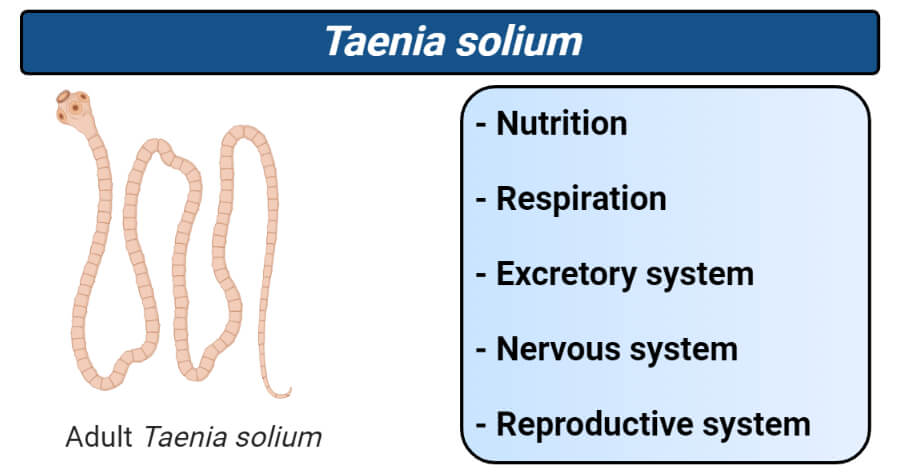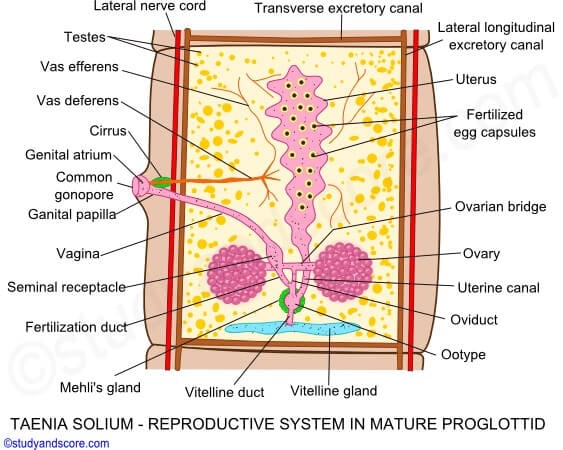
Interesting Science Videos
Nutrition in Taenia solium
- Tapeworm completely lacks alimentation in all stages of life-history.
- It is clear that tapeworms absorb nutrients from their hosts and that such movement of materials from the hosts into parasites is an essential element of host-parasite relationships.
- The soluble nutrients like glucose, amino acids, glycerol, etc., diffuse directly through the general body surface (teguments0.
- The absorptive surface of a parasite is generally increased by the microvilli or teguments.
- Some of the tissue fluid s from the host are probably absorbed by scolex of tapeworm which is anchored deeply into the intestinal mucosa.
- The stored food consists of mainly glycogen and some lipid substances. The glycogen content of T. solium, by net weight, is 2.17%.
Respiration in Taenia solium
- The respiration in tapeworm is mainly anaerobic type or anoxybiotic type as there is no free oxygen available in the human intestine.
- The principal reserve food, glycogen is the main source of energy which undergoes glycolysis to produce carbon dioxide and fatty acids and other organic acids are also produced.
- The carbon dioxide is diffused out through the general body surface, while fatty acids are removed through the excretory system.
- The tapeworm also consumes free oxygen when available.
- The rate of consumption is maximum in anterior proglottids and declines gradually towards the posterior end.
Excretory system of Taenia solium
It consists of an Excretory canal and flame cells.
Excretory canal
- There are, on each side, two lateral longitudinal excretory canals or collecting tubules of which one is dorsal and the other ventral .
- They get connected by a network of tubules or ring-like vesicle called, nephridial plexus in scolex.
- Dorsal canals are thin and are confined to the anterior region of the body.
- Ventral canals are large and extend along the entire length of the body.
- Two ventral canals are connected by a transverse canal at the posterior part of each proglottid (except the last).
- In the last proglottids, they join to form a pulsatile bladder or caudal vesicle, opening to the exterior by a single excretory pore, but when this proglottid is shed off, the caudal vesicle is lost and the terminal of two ventral canals behave as independent excretory pores.
- Each longitudinal excretory canal receives numerous secondary canals all along its length.
Flame cells
- A flame cell is irregular-shaped, with granular cytoplasm and a nucleus.
- These are scattered throughout the parenchyma from which they remove metabolic wastes.
- A bundle of cilia or flame arises from basal granules near the nucleus.
- cilia are enclosed into a funnel-shaped lumen formed by the terminal blind end of a capillary.
- The long cilia of flame cells have the flickering movement which maintains hydrostatic pressure by which wastes is driven into the excretory canal.
Physiology of excretion
- The flame cells are scattered all over the parenchyma cell. With the help of flagellar movements, the excretory products in a fluid state enter into parenchyma to flame cells.
- The longitudinal canals are lined internally by cuticle, while the secondary canal is non-ciliated and capillaries have a ciliated lining.
- The cilia set up the hydrostatic pressures which drive out the excretory products through the excretory canal and out of excretory pores.
- The fluid content of the body is also regulated by this system(osmoregulation) in the case of platyhelminths but in cestodes, the protonephridia concerned only the excretion.
Nervous system of Taenia solium
- The nervous system of T. solium consists of a pair of cerebral ganglia connected by (i) a ring consisting of dorsal and ventral commissures and (ii) a thick ganglionate cross commissures or transverse commissures.
- All the structures together are known as the brain complex, which is connected with another rostellar nerve ring that has a pair of rostellar ganglia in the rostellum. These two rings are interconnected by eight nerves.
- The nerve fibers from cerebral and rostellar ganglia supply the suckers and rostellum.
- 10 longitudinal nerve cords arise from the brain complex and run through strobila. Out of these two lateral longitudinal nerves are best developed.
- The longitudinal nerve cords are connected in each proglottid by a ring connective situated below the transverse excretory canal.
- Sense organs are absent in tapeworm but free sensory nerve-endings are present throughout the body specially scolex.
- A detached proglottid, passing out with feces hows some movements and sensitivity to stimuli.
Reproductive system of Taenia solium
Taenia solium is hermaphrodite. Each proglottid, at maturity, contains a complete set of male and female reproductive organs. The anterior 100 to 150 proglottids of mature proglottids contain only male organs. Male reproductive organs develop first in each proglottid (protandrous) than females. The remaining posterior 250 proglottids develop both male and female reproductive organs.

Image Source: Study and Score.
Male reproductive system
The Male reproductive organs consist of testes, vasa efferentia, vas deferens, cirrus or penis, and genital atrium.
a. Testes
- Testes are numerous small and are scattered along the length and breadth of proglottids.
b. Vasa efferentia
- From each testis arises a fine ductule, the vas efferens.
- Vas efferentia usually gets interconnected with similar ductules from the surrounding of the testes to form a common sperm duct or vas deferens in the middle of proglottids.
c. Vas deferens
- The vas deferens is a thick, convoluted tube which is transverse in position and extends towards the lateral margin (left or right) of the proglottid.
- It opens in the cirrus.
d. Cirrus and cirrus sac
- The cirrus is a thick, muscular, eversible, copulatory organ that is enclosed in a firm cirrus sheath or cirrus sac.
- The cirrus opens by the male gonopore into a cup-shaped genital atrium.
- The genital atrium opens to the exterior by the common gonophore situated at the peak of a tiny protuberance, the genital papilla.
- The common gonophores of successive proglottids lie alternatively on both the side.
Female reproductive system
The female reproductive system consists of a bilobed ovary, oviduct, ootype, vagina, uterus, Mehil’s glands, and vitelline gland.
a. Ovary
- It is also called germarium.
- It is bilobed and lies ventrally in the posterior part of proglottids.
- Each lobe of the ovary is dorso-ventrally flattened and consists of a number of radially-arranged germinal cords or follicles.
- Both the lobes are connected medially by a transverse, tubular bridge, the ovarian bridge, or isthmus.
b. Oviduct
- It is short but wide arises from about the middle of the ovarian isthmus.
- It opens into the Ootype.
c. Ootype
- It is a small, rounded chamber formed by the union of the oviduct, uterus, and vitelline duct.
- It is surrounded by numerous unicellular Mehlis’s glands which secrete a slimy substance that lubricates the eggs in the uterus.
d. Vagina
- It is a bent narrow tubular structure that arises from the female genital pore located behind the male genital pore in the genital atrium.
- It runs obliquely inwards to join the oviduct.
- Before joining the oviduct, the vagina swells up to form a sperm storing sac, the seminal receptacle, or receptaculum seminis.
- The seminal receptacle stores the sperms temporarily.
e. Uterus
- It is a blind and cylindrical tube that arises from Ootype extending up to the anterior part of proglottids.
- It consists of a proximal short and narrow tubular portion, the uterine duct, and distal broad part forming the uterine expansion.
- It contains thousands of fertilized eggs, and in gravid proglottids, it forms 7 to 13 lateral branches on each side.
- The branched uterus is the only genital structure persisting in gravid proglottids.
f. Vitelline gland
- It is a large lobulated gland.
- It is situated at the posterior margin of the proglottids.
- It is connected with the Ootype by a short median vitelline duct.
- It consists of numerous follicles secreting yolk cells.
g. Mehils’s glands
- The Ootype is surrounded by a large number of unicellular glands called Mehil’s glands.
References and Sources
- Pappas P.W. (1985) Nutrient Uptake by Tapeworms. In: Gilles R., Gilles-Baillien M. (eds) Transport Processes, Iono- and Osmoregulation. Proceedings in Life Sciences. Springer, Berlin, Heidelberg. https://doi.org/10.1007/978-3-642-70613-4_29
- 3% – https://www.studyandscore.com/studymaterial-detail/taenia-general-characters-body-wall-nutrition-respiration-excretion-and-nervous-system
- 2% – https://www.biologydiscussion.com/invertebrate-zoology/phylum-platyhelminthes/taenia-solium-habitat-structure-and-life-history/28918
- 2% – https://tardigrade.app/question/fwbxd5dv?next=true
- 1% – https://www.studyandscore.com/studymaterial-detail/taenia-reproductive-system-and-mature-proglottid
- 1% – https://www.iaszoology.com/taenia-solium/2/
- 1% – https://www.biologydiscussion.com/parasitology/parasitic-worm/taenia-solium-linnaeus-history-and-functions/62216
- 1% – http://chestofbooks.com/animals/zoology/Life/Class-Trematoda-Part-3.html
- <1% – https://www.sciencedirect.com/topics/immunology-and-microbiology/cestoda
- <1% – https://the-definition.com/medical-n-health-sciences/vas-deferens
- <1% – https://quizlet.com/60583005/sf-ch-14-the-brain-cranial-nerves-flash-cards/
- <1% – https://quizlet.com/30203156/fluids-flash-cards/
- <1% – https://quizlet.com/29635781/ob-ovaries-flash-cards/
- <1% – https://en.wikipedia.org/wiki/Posterior_tubercle_of_cervical_vertebra
